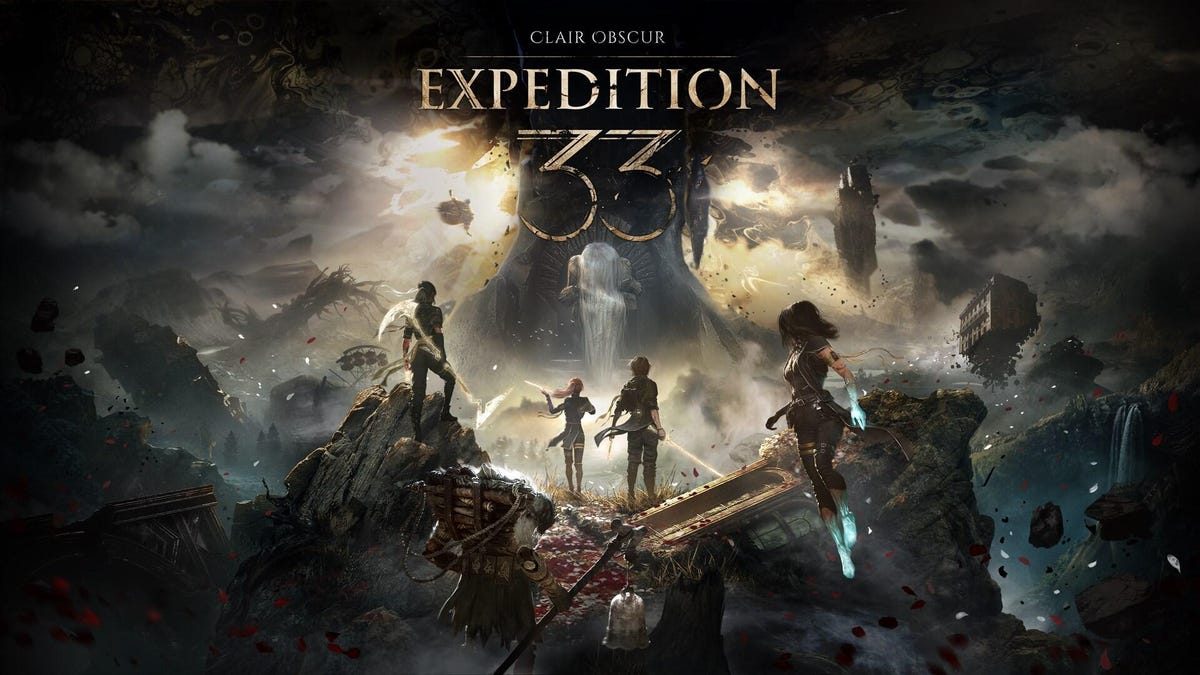Technologies
Clair Obscur Expedition 33 Review: An Achingly Beautiful French Spin on the JRPG Formula
Sandfall Interactive weaves sharp, complex combat through an irresistible story about living in an age of death.

The Japanese RPG genre so venerates its icons, like the Final Fantasy and Dragon Quest series, that new games in its tradition replicate rather than innovate. It took a studio halfway around the world, in France, to make a JRPG that stands out of those titans’ shadows — one so starkly novel in its world and systems that it tells a story you don’t want to put down.
Clair Obscur: Expedition 33, the debut game from French studio Sandfall Interactive, achieves a bundle of superlatives. From the writing to the worldbuilding to the combat to the music, it’s easy to find aspects that are individually excellent. But more importantly, they weave together into a cohesive and thematically potent game that tells a mature story with confidence and style, packing a certain (forgive me) je ne sais quoi that immersed me in a world of passion and loss.
Expedition 33’s story explores a fantasy land at the mercy of a super-powerful being, the Paintress, who has been culling humanity once a year for generations. On a certain day, the residents of seemingly the only city left, Lumière (a devastated Paris, overrun with rubble and vines), bittersweetly gather to bid their loved ones adieu. They watch as, far off in the distance, the Paintress lowers a glowing, omnivisible number by one. Slowly, anyone that age disappears into dust, and humanity’s age limit is reduced again.
Lumière resists by sending armed groups of volunteers over the ocean into the wilderness every year to defeat the Paintress — and though they’ve been so far unsuccessful, the tradition lives on, populated by desperate believers and older soldiers choosing to use their little time left to challenge fate.
Gathering a collection of plucky adventurers to take on God for the sake of the world is textbook JRPG, but the tones of most games in the genre oscillate between the puerile extremes of naive optimism and cynical nihilism. Sandfall Interactive’s story instead envisions characters embarking from a society fluent in despair and still taking action, channeling anxiety into a belief in resolute progress. Throughout the game, the main characters repeat their city’s mantras: «For those who come after,» and, «Tomorrow comes.» Earning meaning, even in a slowly constricting apocalypse.
Through the game’s commitment to its tone, its prism of beauties shines through. The plot, alternating between sublime wonder of a vibrant new land and brutal reckonings in a world without sympathies, is full of surprises. The music is tenderly emotional, with haunting piano and violin arranged by composer Lorien Testard and achingly, hauntingly beautiful singing by Alice Duport-Percier for an hours-long original soundtrack, as Expedition 33 producer François Meurisse told me.
The wild, friendly characters you meet, the stunningly gorgeous environments, dappled with light and shadow, the truly excellent English voice cast — the game is a symphony of well-executed elements that combine into something new.
That alchemy of novelty leads to a feeling that’s rare among JRPGS, let alone games as a whole: Frequently along the way, I truly didn’t know what to expect next. For gamers jaded by tropes and tradition, a game grappling with death in uncharted territory is like water in a desert.
All of which wouldn’t matter if the game wasn’t a riot to play.
Fighting against fate with soulslike turn-based combat
Unlike more open-ended RPGs such as this year’s Avowed and The Elder Scrolls 4: Oblivion Remaster or 2023’s excellent Baldur’s Gate 3, there isn’t any choice in how Expedition 33’s story goes — at least as far as I’ve experienced in a little over 20 hours of the game. Where you do get control is in the battle system, which provides some of the most interactive turn-based fights I’ve ever played.
That’s primarily due to the reactive capabilities built into the system. Players can press a button to dodge when enemies attack with a pretty generous window. Those with more confidence can try to parry attacks, and if done for the entire enemy combo, the character will counter for severe damage. It took me around a dozen hours to be confident enough in timing to successfully parry attacks, though you can reduce the difficulty or equip particular abilities to mitigate that. Later in the game, there are even more enemy attack mechanics.
The defense system was inspired by FromSoftware games like Dark Souls and Elden Ring, though there are also parts of the game inspired by Final Fantasy 10 and Persona 5, producer Meurisse told me. The latter is evident when switching between submenus in combat, which slightly shifts the camera view — «every button you click triggers some camera movement,» Meurisse said.
The cast of characters you gather isn’t large, but each has unique skills and their own distinct mechanic that functions almost like a turn-by-turn mini-game to ramp up damage potential. For protagonist Gustave, attacking builds up charges to unleash in a massive lightning attack; Lune the mage gets elemental «stains» after casting spells that can be spent to empower later spells; the fencer Maelle switches between stances every time she uses a skill.
Some other aspects are more conventional, with a range of status effects that can be applied to enemies like a damage-over-time burn, a slow or marking the enemy to take higher damage. But players can also, through guns or unspecified magic, shoot enemies to target weak points. Each shot costs AP, the resource used to also power spells and skills, so it takes some restraint not to gleefully fire off volleys.
Which is a lot to keep in mind already, but the Picto system escalates the complexity. Pictos are essentially bonus passive abilities that characters can equip up to three of at a time. After a handful of battles, they can unequip the PIcto and add its ability to their character, provided they have enough ability points to afford it. Juggling this budget is key to the late game and, incidentally, to breaking the combat altogether: Many of these Pictos offer bonus damage or effect if conditions are met, like they attack an enemy that already has a status effect. With scores of these Pictos picked up across the game, players can make builds and synergize between characters to rack up dizzying damage totals.
Mastering the deep combat and deeper Picto system is a joy for the RPG fan who loves diving into granular strategies, making short fights and long boss battles more engaging and interactive than most other JRPGs. It satisfies a crunchy part of the brain that delights in overclocking a system willingly ripe for abuse from the determined player. And it serves as both a distraction from and a harmony with the themes of the game — of companions soaked in a lifetime of death vainly endeavoring to stop it for «those who come after» until, inevitably, they’re cut down too.
Expedition 33’s dance with death and meaning
When I heard that a French game studio was taking on the venerable JRPG genre, I jokingly wondered how many berets, baguettes and mimes would make it in. Plenty, it turns out, as you can fight some surreal, optional and tough mime mini-bosses. Do so and claim ridiculous but chic outfits for the main characters wearing sunglasses, berets and long loaves of bread strapped to their backs like swords.
Expedition 33 embraces this oddness as a complement to its melancholy tone, and it’s all the richer for it. There’s something beyond the stereotypical French organ music and mimes that Sandfall Interactive admirably threw in — a desire to tell a story not just about a different world but how people muddle through its severe and unfair limits to reach some meaningful end anyway. In the absence of JRPG tropes like the plucky, annoying protagonist ticking off Joseph Campbell’s heroic checklist, Expedition 33 is populated with somber realists devoted to each other but expecting loss, all in dedication to a future they believe they won’t see.
Expedition 33 was partly inspired by a 2004 French novel called La Horde du Contrevent («The Horde of Counterwind»), Meurisse said, a cult classic telling the story of successive expeditions of people sent to find the origin of world-warping winds. Similarly, the Paintress ticking down humanity is an unknowable force at the world’s edge, and pushing back against her seems futile.
Over the course of the game, I discovered journals from previous years’ expeditions, each trying a new way to succeed where others failed, some ending humorously or ignobly, others in a grim blaze of glory. But I found their bodies regardless, locked in a final pose, bronzed in a strange process as begets all humans venturing beyond their city — a marker for those who follow, and hopefully, surpass.
The strange landscape beyond Lumière is forever changed by the Fracture, a calamity that happened a century ago before the Paintress started ticking down humanity’s clock. In its wake, islands float in the sky and antediluvian buildings meld into dirt and rock. With the light dappling through the trees or around airborne archipelagos, I frequently stopped to stare at the landscapes, as beautifully alien to me as to the characters of the game. I’ve racked up over a hundred screenshots, mostly of areas where I was struck with awe.
Clair Obscur Expedition 33 Screenshots: Beauty and Wonder in a World of Death
In chatting with Meurisse, I asked him what was uniquely French about the game, and he listed the clothes and architecture inspired by France’s Belle Epoque era of the late 1800s and Art Deco stylings, which are featured in the gilded gold-and-black walls of the doomed buildings, long abandoned and entombed in the dirt beyond humanity’s reach. But there’s another perspective blended into Expedition 33 that is different and fresh — creating a world where its characters still bask in wonder even when swimming in death.
I did, too.
Expedition 33 will be celebrated for its many excellences, and deservedly so. But above all, it tells an adult story about what’s left for us when the future is ripped away bit by bit — and why it’s worth fighting against the inevitable anyway. You never know what wonder you’ll get to see before the end.
Clair Obscur: Expedition 33 is available now on PC, PS5 and Xbox Series X and S.
Technologies
OpenAI Launches ChatGPT Atlas, Challenging Google Chrome With an AI-First Browser
The browser is available now for MacOS users, with versions for Windows, iOS and Android coming later.

OpenAI has released a generative AI-powered web browser called ChatGPT Atlas, a major step in the company’s expansion beyond its ChatGPT chatbot platform. The browser, announced Tuesday, integrates ChatGPT’s capabilities directly into the browsing experience, aiming to make web use more interactive and chatbot-like.
OpenAI sparked speculation earlier Tuesday after posting a teaser on its X account showing a series of browser tabs. During the YouTube livestream, CEO Sam Altman and others announced the browser and live-demoed a few of the new features now available for MacOS users worldwide. Support for Windows, iOS and Android operating systems is «coming soon,» the company said.
(Disclosure: Ziff Davis, CNET’s parent company, in April filed a lawsuit against OpenAI, alleging it infringed Ziff Davis copyrights in training and operating its AI systems.)
The new product launch comes amid growing competition among tech companies to embed AI assistants more deeply into everyday tools. For instance, Google has already integrated Gemini into its Chrome browser to add AI to the online browsing experience. Earlier this year, the AI search tool developer Perplexity launched Comet, an AI-powered Chromium-based web browser. Here’s everything OpenAI announced today.
Don’t miss any of our unbiased tech content and lab-based reviews. Add CNET as a preferred Google source.
What is ChatGPT Atlas?
ChatGPT Atlas looks and functions like a traditional web browser. It includes tabs, bookmarks, extensions and incognito mode, but adds popular ChatGPT functions and features throughout. Opening a new tab lets you either enter a URL or ask ChatGPT a question. The browser includes separate tabs for different types of results, such as search links, images, videos and news.
A built-in ChatGPT sidebar can analyze whatever page you’re viewing to provide summaries, explanations or quick answers without leaving the site. ChatGPT can also offer in-line writing assistance, suggesting edits and completions inside any text field, such as an email draft.
One of the biggest new features is browser memory, which keeps track of pages and topics you’ve previously explored. Atlas can suggest related pages, help you return to past research or automate repetitive tasks. Memory is optional and can be viewed, edited or deleted at any time in settings.
Atlas also supports natural language commands, meaning you could type something like «reopen the shoes I looked at yesterday» or «clean up my tabs» and the browser should respond accordingly.
Read more: OpenAI Plans to Allow Erotica and Change Mental Health Restrictions for Adult Users
Agent mode in Atlas preview
OpenAI also previewed agent mode, which lets ChatGPT take limited actions on behalf of the user — such as booking travel, ordering groceries or gathering research. The company says the mode is faster than standard ChatGPT and comes with new safeguards to keep users in control.
Agent mode is available to Plus and Pro subscribers, and is available in beta for Business users.
«In the same way that GPT-5 and Codex are these great tools for vibe coding, we believe we can start in the long run to have an amazing tool for vibe lifing,» Will Ellsworth, the research lead for agent mode in Atlas, said during the livestream. «So delegating all kinds of tasks both in your personal and professional life to the agent in Atlas.»
How to get started with ChatGPT Atlas
To get started, you’ll first download Atlas at chatgpt.com/atlas. When you open Atlas for the first time, you’ll need to sign in to your ChatGPT account.
From there, you can import your bookmarks, saved passwords and browsing history from your current browser.
Technologies
Amazon Will Pay $2.5 Billion for Misleading Customers Into Amazon Prime Subscriptions
Amazon settles its FTC lawsuit, and agrees to pay billions for «tricking» customers into Prime subscriptions.

In September, Amazon settled its case with the Federal Trade Commission over whether it had misled customers who signed up for Amazon Prime. The $2.5 billion settlement is one of the largest consumer protection settlements in US history, and while Amazon did not admit to wrongdoing, it’s still changing things.
The FTC said $1.5 billion will go into a fund to repay eligible subscribers, with the remaining $1 billion collected as a civil penalty. The settlement requires Amazon to add a «clear and conspicuous» option to decline Prime during checkout and to simplify the cancellation process.
«Amazon and our executives have always followed the law, and this settlement allows us to move forward and focus on innovating for customers,» Mark Blafkin, Amazon senior manager, said in a statement. «We work incredibly hard to make it clear and simple for customers to both sign up or cancel their Prime membership, and to offer substantial value for our many millions of loyal Prime members around the world.»
Don’t miss any of our unbiased tech content and lab-based reviews. Add CNET as a preferred Google source.
Why was the FTC suing Amazon?
The FTC filed suit against Amazon in 2023, accusing it of using «dark patterns» to nudge people into Prime subscriptions and then making it too hard to cancel. The FTC maintained Amazon was in violation of Section 5 of the FTC Act and the Restore Online Shoppers’ Confidence Act.
«Specifically, Amazon used manipulative, coercive or deceptive user-interface designs known as ‘dark patterns’ to trick consumers into enrolling in automatically renewing Prime subscriptions,» the FTC complaint states.
Who is eligible for Amazon’s big payout?
Amazon’s legal settlement is limited to customers who enrolled in Amazon Prime between June 23, 2019, and June 23, 2025. It’s also restricted to customers who subscribed to Prime using a «challenged enrollment flow» or who enrolled in Prime through any method but were unsuccessful in canceling their memberships.
The FTC called out specific enrollment pages, including Prime Video enrollment, the Universal Prime Decision page, the Shipping Option Select page and the Single Page Checkout. To qualify for a payout, claimants must also not have used more than 10 Amazon Prime benefits in any 12-month period.
Customers who signed up via those challenged processes and did not use more than three Prime benefits within one year will be paid automatically by Amazon within 90 days. Other eligible Amazon customers will need to file a claim, and Amazon is required to send notices to those people within 30 days of making its automatic payments.
Customers who did not use a challenged sign-up process but instead were unable to cancel their memberships will also need to file claims for payment.
How much will the Amazon payments be?
Payouts to eligible Amazon claimants will be limited to a maximum of $51. That amount could be reduced depending on the number of Amazon Prime benefits you used while subscribed to the service. Those benefits include free two-day shipping, watching shows or movies on Prime Video or Whole Foods grocery discounts.
Technologies
This Rumored Feature Could Make NotebookLM Essential for Work as Well as School
NotebookLM takes another step toward being the do-it-all AI tool for work and school.

Since it launched, NotebookLM has been aimed at students. While just about anyone can use the AI tool to some benefit, it’s a great study buddy thanks to an assortment of features for the classroom. But a promising new feature may help with your next work presentation: Slides.
Powered by Gemini, NotebookLM can help you brainstorm ideas and generate audio or video overviews. That sounds like most AI tools, but NotebookLM is different. You can provide it with your own material — documents, websites, YouTube videos and more — and it’ll only use those sources to answer your questions and generate content. Adding a slide generator to such a tool would be a solid, professional power-up.
Don’t miss any of our unbiased tech content and lab-based reviews. Add CNET as a preferred Google source.
Google already has its own slide deck creation tool, but NotebookLM could make it even easier to create them. Using your uploaded sources and the recently integrated Nano Banana image generator, the ability to create a slide deck on the fly could soon be on its way.
The tech and AI tool-focused site Testing Catalog recently spotted an unreleased and incomplete Slide tool. Not all of the features seem to be available, but it’d be easy to assume you’ll be able to create a slide deck based on your uploaded documents with just a few clicks. It’ll also likely allow you to further customize the deck by giving NotebookLM specific instructions and topics within your sources to focus on.
That’s not all, though. Another, similar feature might also be on the way. Also spotted was an option to generate an infographic — allowing you to create a visual chart or image based on your data sources. We’ll have to wait and see when either of these features goes live, but NotebookLM remains a robust tool that has little competition, and I expect it’ll only get better.
-

 Technologies3 года ago
Technologies3 года agoTech Companies Need to Be Held Accountable for Security, Experts Say
-

 Technologies3 года ago
Technologies3 года agoBest Handheld Game Console in 2023
-

 Technologies3 года ago
Technologies3 года agoTighten Up Your VR Game With the Best Head Straps for Quest 2
-

 Technologies4 года ago
Technologies4 года agoVerum, Wickr and Threema: next generation secured messengers
-

 Technologies4 года ago
Technologies4 года agoBlack Friday 2021: The best deals on TVs, headphones, kitchenware, and more
-

 Technologies4 года ago
Technologies4 года agoGoogle to require vaccinations as Silicon Valley rethinks return-to-office policies
-

 Technologies4 года ago
Technologies4 года agoOlivia Harlan Dekker for Verum Messenger
-

 Technologies4 года ago
Technologies4 года agoiPhone 13 event: How to watch Apple’s big announcement tomorrow
